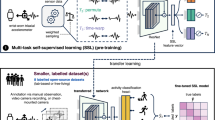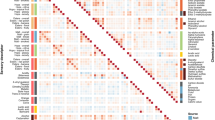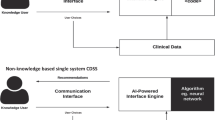Abstract
Vital signs, including heart rate and body temperature, are useful in detecting or monitoring medical conditions, but are typically measured in the clinic and require follow-up laboratory testing for more definitive diagnoses. Here we examined whether vital signs as measured by consumer wearable devices (that is, continuously monitored heart rate, body temperature, electrodermal activity and movement) can predict clinical laboratory test results using machine learning models, including random forest and Lasso models. Our results demonstrate that vital sign data collected from wearables give a more consistent and precise depiction of resting heart rate than do measurements taken in the clinic. Vital sign data collected from wearables can also predict several clinical laboratory measurements with lower prediction error than predictions made using clinically obtained vital sign measurements. The length of time over which vital signs are monitored and the proximity of the monitoring period to the date of prediction play a critical role in the performance of the machine learning models. These results demonstrate the value of commercial wearable devices for continuous and longitudinal assessment of physiological measurements that today can be measured only with clinical laboratory tests.
This is a preview of subscription content, access via your institution
Access options
Access Nature and 54 other Nature Portfolio journals
Get Nature+, our best-value online-access subscription
$29.99 / 30 days
cancel any time
Subscribe to this journal
Receive 12 print issues and online access
$209.00 per year
only $17.42 per issue
Buy this article
- Purchase on Springer Link
- Instant access to full article PDF
Prices may be subject to local taxes which are calculated during checkout





Similar content being viewed by others
Data availability
Intel Basis watch data are available on the Stanford iPOP site (http://ipop-data.stanford.edu/wearable_data/Stanford_Wearables_data.tar) and in the Digital Health Data Repository48 (https://github.com/DigitalBiomarkerDiscoveryPipeline/Digital_Health_Data_Repository/tree/main/Dataset_StanfordWearables). Data that are unique to this study are included as source data and in the supplementary tables. Source data are provided with this paper.
Code availability
R version 3.3.3 was used with the base packages and the following additional CRAN packages: stats, glmnet, lme4, randomForest and PMA. Custom scripts were used for data analysis and are open source via github.com/jessilyn/wearables_vitalsigns (https://doi.org/10.5281/zenodo.4661493), and wearables data pre-processing scripts are available on the Digital Biomarker Discovery Pipeline (https://DBDP.org)48.
References
Sackett, D. L. The rational clinical examination. A primer on the precision and accuracy of the clinical examination. J. Am. Med. Assoc. 267, 2638–2644 (1992).
Hatala, R. et al. An evidence-based approach to the clinical examination. J. Gen. Intern. Med. 12, 182–187 (1997).
Armbruster, D. & Miller, R. R. The Joint Committee for Traceability in Laboratory Medicine (JCTLM): a global approach to promote the standardisation of clinical laboratory test results. Clin. Biochem. Rev. 28, 105–113 (2007).
Sudlow, C. et al. UK biobank: an open access resource for identifying the causes of a wide range of complex diseases of middle and old age. PLoS Med. 12, e1001779 (2015).
Nagai, A. et al. Overview of the BioBank Japan Project: study design and profile. J. Epidemiol. 27, S2–S8 (2017).
Vaithinathan, A. G. & Asokan, V. Public health and precision medicine share a goal. J. Evid. Based Med. 10, 76–80 (2017).
Shcherbina, A. et al. Accuracy in wrist-worn, sensor-based measurements of heart rate and energy expenditure in a diverse cohort. J. Pers. Med. 7, 3 (2017).
Li, X. et al. Digital health: tracking physiomes and activity using wearable biosensors reveals useful health-related information. PLoS Biol. 15, e2001402 (2017).
Radin, J. W., Topol, E. & Steinhubl, S. Harnessing wearable device data to improve state-level real-time surveillance of influenza-like illness in the USA: a population-based study. Lancet Digit. Health 2, 85–93 (2020).
Nemati, S. et al. Monitoring and detecting atrial fibrillation using wearable technology. Annu. Int. Conf. IEEE Eng. Med. Biol. Soc. 2016, 3394–3397 (2016).
Suzuki, T., Kameyama, K. & Tamura, T. Development of the irregular pulse detection method in daily life using wearable photoplethysmographic sensor. Annu. Int. Conf. IEEE Eng. Med. Biol. Soc. 2009, 6080–6083 (2009).
Steinhubl, S. R. et al. Rationale and design of a home-based trial using wearable sensors to detect asymptomatic atrial fibrillation in a targeted population: the mHealth Screening To Prevent Strokes (mSToPS) trial. Am. Heart J. 175, 77–85 (2016).
Hannun, A. Y. et al. Cardiologist-level arrhythmia detection with convolutional neural networks. Nat. Med. 25, 65–69 (2019).
Avram, R. et al. Predicting diabetes from photoplethysmography using deep learning. J. Am. Coll. Cardiol. 73 (2019).
Steinhubl, S. R. et al. Validation of a portable, deployable system for continuous vital sign monitoring using a multiparametric wearable sensor and personalised analytics in an Ebola treatment centre. BMJ Glob. Health 1, e000070 (2016).
Chen, R. et al. Personal omics profiling reveals dynamic molecular and medical phenotypes. Cell 148, 1293–1307 (2012).
Piening, B. D. et al. Integrative personal omics profiles during periods of weight gain and loss. Cell Syst. 6, 157–170 e158 (2018).
Zhou, W. et al. Longitudinal multi-omics of host-microbe dynamics in prediabetes. Nature 569, 663–671 (2019).
Schussler-Fiorenza Rose, S. M. et al. A longitudinal big data approach for precision health. Nat. Med. 25, 792–804 (2019).
Albanese, M., Neofytou, M., Ouarrak, T., Schneider, S. & Schols, W. Evaluation of heart rate measurements in clinical studies: a prospective cohort study in patients with heart disease. Eur. J. Clin. Pharm. 72, 789–795 (2016).
Kavsaoglu, A. R., Polat, K. & Hariharan, M. Non-invasive prediction of hemoglobin level using machine learning techniques with the PPG signal’s characteristics features. Appl. Soft Comput. 37, 983–991 (2015).
Mandal, S. & Manasreh, M. O. An in-vitro optical sensor designed to estimate glycated hemoglobin levels. Sensors (Basel) 18, 1084 (2018).
Boucsein, W. et al. Publication recommendations for electrodermal measurements. Psychophysiology 49, 1017–1034 (2012).
Wilson, P. W. et al. Prediction of coronary heart disease using risk factor categories. Circulation 97, 1837–1847 (1998).
Welch, H. G., Chapko, M. K., James, K. E., Schwartz, L. M. & Woloshin, S. The role of patients and providers in the timing of follow-up visits. telephone care study group. J. Gen. Intern. Med. 14, 223–229 (1999).
Reule, S. & Drawz, P. E. Heart rate and blood pressure: any possible implications for management of hypertension? Curr. Hypertens. Rep. 14, 478–484 (2012).
Palatini, P. et al. Reproducibility of heart rate measured in the clinic and with 24-hour intermittent recorders. Am. J. Hypertens. 13, 92–98 (2000).
Bloomfield, H. E. & Wilt, T. J. Evidence brief: role of the annual comprehensive physical examination in the asymptomatic dult. in VA Evidence-Based Synthesis Program Evidence Briefs (Department of Veterans Affairs, 2011).
Ikeda, N. et al. Effects of submaximal exercise on blood rheology and sympathetic nerve activity. Circ. J. 74, 730–734 (2010).
Weinberg, A. D. & Minaker, K. L. Dehydration. Evaluation and management in older adults. Council on Scientific Affairs, American Medical Association. J. Am. Med. Assoc. 274, 1552–1556 (1995).
Xiao, H., Barber, J. & Campbell, E. S. Economic burden of dehydration among hospitalized elderly patients. Am. J. Health Syst. Pharm. 61, 2534–2540 (2004).
Avram, R. et al. Real-world heart rate norms in the health eHeart study. NPJ Digit. Med. 2, 58 (2019).
St John, A. & Price, C. P. Existing and emerging technologies for point-of-care. Test. Clin. Biochem. Rev. 35, 155–167 (2014).
Londeree, W., Davis, K., Helman, D. & Abadie, J. Bodily fluid analysis of non-serum samples using point-of-care testing with iSTAT and Piccolo analyzers versus a fixed hospital chemistry analytical platform. Hawaii J. Med. Public Health 73, 3–8 (2014).
Hall, H. et al. Glucotypes reveal new patterns of glucose dysregulation. PLoS Biol. 16, e2005143 (2018).
Zeevi, D. et al. Personalized nutrition by prediction of glycemic responses. Cell 163, 1079–1094 (2015).
Parlak, O., Keene, S. T., Marais, A., Curto, V. F. & Salleo, A. Molecularly selective nanoporous membrane-based wearable organic electrochemical device for noninvasive cortisol sensing. Sci. Adv. 4, eaar2904 (2018).
Emaminejad, S. et al. Autonomous sweat extraction and analysis applied to cystic fibrosis and glucose monitoring using a fully integrated wearable platform. Proc. Natl Acad. Sci. USA 114, 4625–4630 (2017).
Whelton, P. K. et al. 2017 ACC/AHA/AAPA/ABC/ACPM/AGS/APhA/ASH/ASPC/NMA/PCNA Guideline for the prevention, detection, evaluation, and management of high blood pressure in adults: a report of the american college of cardiology/american heart association task force on clinical practice guidelines. J. Am. Coll. Cardiol. 71, e127–e248 (2018).
Cadmus-Bertram, L., Gangnon, R., Wirkus, E. J., Thraen-Borowski, K. M. & Gorzelitz-Liebhauser, J. The accuracy of heart rate monitoring by some wrist-worn activity trackers. Ann. Intern. Med. 166, 610–612 (2017).
Hastie, T. & Fithian, W. Response to ‘Perils of LOO crossvalidation’. https://not2hastie.tumblr.com/post/56630997146/i-must-confess-i-was-surprised-by-the-negative (2013).
Poldrack, R. The perils of leave-one-out crossvalidation for individual difference analyses. russpoldrack.org http://www.russpoldrack.org/2012/12/the-perils-of-leave-one-out.html (2012).
Friedman, J., Hastie, T. & Tibshirani, R. Regularization paths for generalized linear models via coordinate descent. J. Stat. Softw. 33, 1–22 (2010).
Tibshirani, R. Regression shrinkage and selection via the lasso. J. R. Stat. Soc. Series B Stat. Methodol. 58, 267–288 (1996).
Breiman, L. Random Forests. Mach. Learn. 45, 5–32 (2001).
Witten, D. M., Tibshirani, R. & Hastie, T. A penalized matrix decomposition, with applications to sparse principal components and canonical correlation analysis. Biostatistics 10, 515–534 (2009).
Hardoon, D. R. S.-T.J. Sparse canonical correlation analysis. Mach. Learn. 83, 331–353 (2011).
Bent, B. et al. The digital biomarker discovery pipeline: an open source software platform for the development of digital biomarkers using mHealth and wearables data. J. Clin. Transl. Sci. 5, E19 (2021).
Acknowledgements
The work was supported by grants from the National Institues of Health (NIH) Common Fund Human Microbiome Project (HMP) (1U54DE02378901), an NIH National Center for Advancing Translational Science Clinical and Translational Science Award (UL1TR001085), and the Chan Zuckerberg Initiative Donor-Advised Fund (an advised fund of Silicon Valley Community Foundation; 2020-218599). JD, LK, RR and JH were supported by the Mobilize Center grant (NIH U54 EB020405). SMS-FR was supported by an NIH Career Development Award (no. K08 ES028825). JD is a MEDx Investigator and a Whitehead Scholar. The Stanford Translational Research Integrated Database Environment (STRIDE) is a research and development project at Stanford University that aims to create a standards-based informatics platform supporting clinical and translational research. We thank the participants who generously gave their time and biological samples for this study. The content is solely the responsibility of the authors and does not necessarily represent the official views of the NIH or the Department of Veteran Affairs.
Author information
Authors and Affiliations
Contributions
J.D., L.K., T.H. and M.P.S. conceived and designed the study; J.D., L.K., J.H., T.H., M.P.S. and S.D. carried out the methods; J.D., R.R., X.L. and A.B. curated the data; J.D., L.K., R.R. and D.W. analyzed the data; J.D., L.K., J.H., S.M.S.-F.R. and M.P.S. wrote the manuscript; and M.P.S., S.D. and J.D. obtained funding.
Corresponding authors
Ethics declarations
Competing interests
M.P.S. is a cofounder of Personalis, SensOmics, Qbio, January AI, Filtricine, Protos, and NiMo, and is on the scientific advisory board of Personalis, SensOmics, Qbio, January AI, Filtricine, Protos, NiMo, and Genapsys. All other authors have no competing interests.
Additional information
Peer review information Nature Medicine thanks Hugo Aerts and the other, anonymous, reviewer(s) for their contribution to the peer review of this work. Michael Basson was the primary editor on this article and managed its editorial process and peer review in collaboration with the rest of the editorial team.
Publisher’s note Springer Nature remains neutral with regard to jurisdictional claims in published maps and institutional affiliations.
Extended data
Extended Data Fig. 2 Model accuracy changes over time based on window of historical data from an individual.
a, Lasso regularized regression using features calculated using different windows of wearable device monitoring. b, Accuracy of the HCT cVS mixed effects models over time for two example patients that were monitored between 2.5–5 years at Stanford hospital with >50 HCT observations at separate clinic visits. The HCT cVS mixed effects models demonstrate that the model accuracy changes over time, and particularly with a dramatic health event like a myocardial infarction (ICD code I21.4) (red vertical line) or a life-threatening ED visit (blue vertical line; CPT code 99285).
Extended Data Fig. 3 Increasing amounts of personalized data open up new study and model possibilities.
a, Summary of different biomedical data collection modalities and the typical amount of data they result in. b, Demonstration of how the amount and modality of data collection (longitudinal continuous vs. discrete measurements) constrain the type and complexity of models that can be built from the data.
Supplementary information
Supplementary Information
Supplementary Tables 1–3
Source data
Source Data Fig. 1
This file contains a table of data underlying Fig. 1d,e.
Source Data Fig. 3
This file contains a table of data underlying Fig. 3a,d.
Rights and permissions
About this article
Cite this article
Dunn, J., Kidzinski, L., Runge, R. et al. Wearable sensors enable personalized predictions of clinical laboratory measurements. Nat Med 27, 1105–1112 (2021). https://doi.org/10.1038/s41591-021-01339-0
Received:
Accepted:
Published:
Issue Date:
DOI: https://doi.org/10.1038/s41591-021-01339-0
This article is cited by
-
Assessment of 24-hour physical behaviour in adults via wearables: a systematic review of validation studies under laboratory conditions
International Journal of Behavioral Nutrition and Physical Activity (2023)
-
Smartwatches in healthcare medicine: assistance and monitoring; a scoping review
BMC Medical Informatics and Decision Making (2023)
-
Wearable based monitoring and self-supervised contrastive learning detect clinical complications during treatment of Hematologic malignancies
npj Digital Medicine (2023)
-
Digital health for aging populations
Nature Medicine (2023)
-
Detecting chronic kidney disease by electrocardiography
Communications Medicine (2023)



